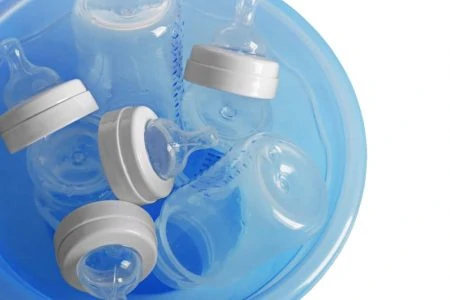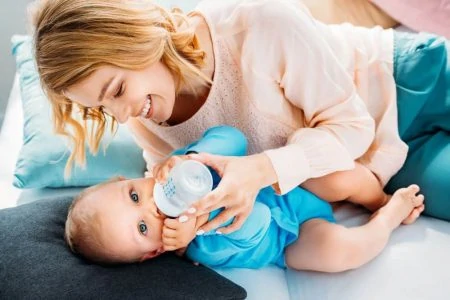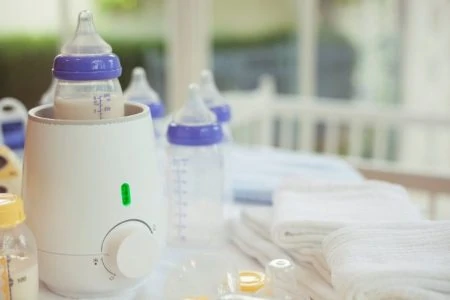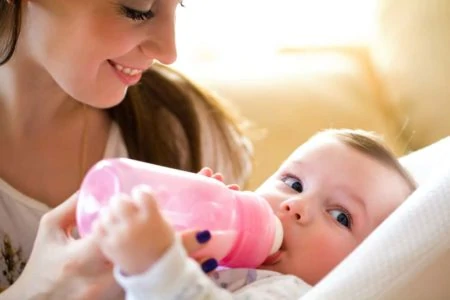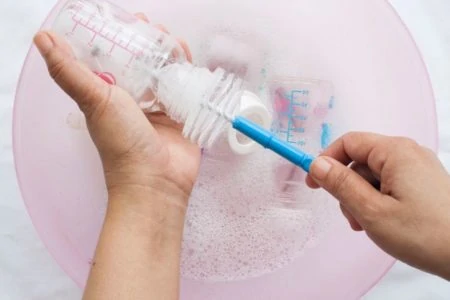Baby bottles come with so many pieces and parts — especially if you have more than one type of bottle. Then you have the drying rack, bottle brush, sterilizing equipment, and bottle warmer. And if you have older children, you probably have sippy cups and water bottles to deal with. It’s no wonder our kitchen cabinets are a disaster!
But don’t worry, we’ve consulted the organizing pros and have come up with a solution.
This guide will take you through our simple steps to organize and store your baby bottles, so you can get that mess under control.
Key Takeaways
- Prepare by setting aside zones in your kitchen for bottle and sippy-cup-related tasks such as washing, sterilizing, and storing.
- Sort, then store. Don’t buy any storage products until you figure out what items you need to store and how many you have.
- Group like with like by keeping similar items together.
- Try to stick to one brand of bottle and sippy cup. It’s especially convenient if your cups and bottles have interchangeable parts.
- If you plan to have more babies, consider keeping your baby bottles for your next little one, but check all the bottles for deep scratches, cracks, or discoloration and ensure they are BPA-free.
Preparing For Kitchen Cupboard Clutter Rescue
If you’ve ever tried to organize and found yourself sitting in more of a mess than you started with, you probably didn’t prep beforehand.
You can’t just start pulling everything out without a replacement plan. Organizing is like buying new sheets — once you take them out of the package, they’re never going back in the same way.
If you need inspiration for your organized kitchen, this video shows great baby bottle organization tips and a drool-worthy pantry arrangement.
Now that you’re inspired, here’s what you need to know before we get started:
- Set aside zones: In addition to your cupboards, designate zones in your kitchen for bottle and sippy-cup-related functions. These include washing, sterilizing, and storing. Baby bottles and their many parts can easily take over without a specific drying spot. It’s worth it to invest in a good bottle drying rack, which you’ll want to keep near your sterilizer.
- Sort then store: To avoid wasting money on storage products you may not need, don’t buy anything for storing your bottles and sippy cups until you figure out what items you’ll need to store and how many you have.
- Assess your needs: Think about how often your child uses a bottle or sippy cup and how often you’re willing to wash and sterilize. For babies still using bottles, plan to have enough bottles so you only have to sterilize once a day. For older children, limit it to enough sippy cups for one to two days. Most kids will only use their favorites, and the rest take up valuable space.
- Be prepared to purge: If you want to tame your cupboard clutter, be ready to part ways with some items. They may be items you’ve been clinging to for sentimental reasons or holding on to just in case. (Hint: “just in case” usually means you’ll never need it.)
One thing to note — if you plan to have more babies, consider keeping your baby bottles for your next little one. Just be sure to check all the bottles for deep scratches, cracks, or discoloration.
Remember
This is because, over time, the nipples degrade, changing the rate of flow of the formula/breast milk, making it more difficult for newborns to feed (1).
Organizing Baby Bottles And Sippy Cups
After you’ve gathered all the bottles or sippy cups from your cupboards and have gone through them and purged unnecessary, you’re ready to tackle what’s left.
1. Group Like with Like
If you have kids of multiple ages, there probably are sippy cups and bottles for different ages. Try to organize these as best as possible, keeping similar items together.
When doing this in my kitchen, it was helpful to spread everything out across my dining room table to see the full “collection” at a glance. Then I could decide which items belonged together. Once grouped into categories, I could see how much space I needed to store each type of item.
Take Note
Having multiples of the same types makes it easier to organize than having a range of sippy cups or bottle parts that don’t coordinate.
2. Choose Your Storage Solutions
After grouping all the items, it’s easy to choose the best size of storage containers. There are a variety of available options at most dollar stores, from styles designed especially for bottles to generic totes and bins.
If your cupboard space is limited, consider using rolling carts with drawers to store your cups and bottles and smaller shelves with drawers to organize small parts like lids, nipples, and straws.
Next, take stock of your cabinets, and decide which items go where.
Life Saver
3. Store Your Items
Now we’re ready for the most satisfying part — putting things where they belong! This is the point where you get to see the results of your hard work.
Take Note
One exception to this rule is sterilized baby bottles. If you have the kitchen space and a zone for washing and sterilizing, it may be easiest to leave the sterilized bottle in the bottle sterilizer until the next feeding.
4. Label Everything
Here’s where you get to express some creativity. You can use anything from masking tape to standard labels to personalized vinyl labels made with a craft label maker.
Label each container by its contents, and face all labels outward in your cupboards.
The best part of labeling is that it lets other people help you. Clear labels show other family members where to find things without the need to tear apart the whole cupboard. Hopefully, it also makes it easier for them to put items away.
